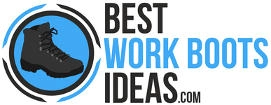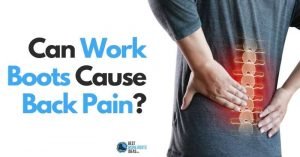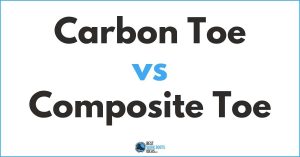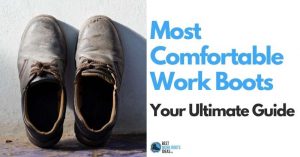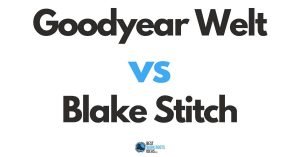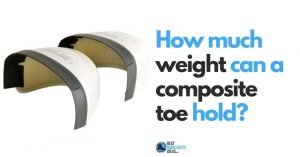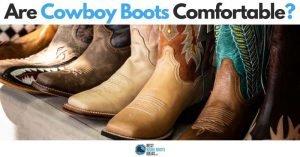Hiking Boots vs Work Boots: What is the difference or are they similar? Learn all you need to know
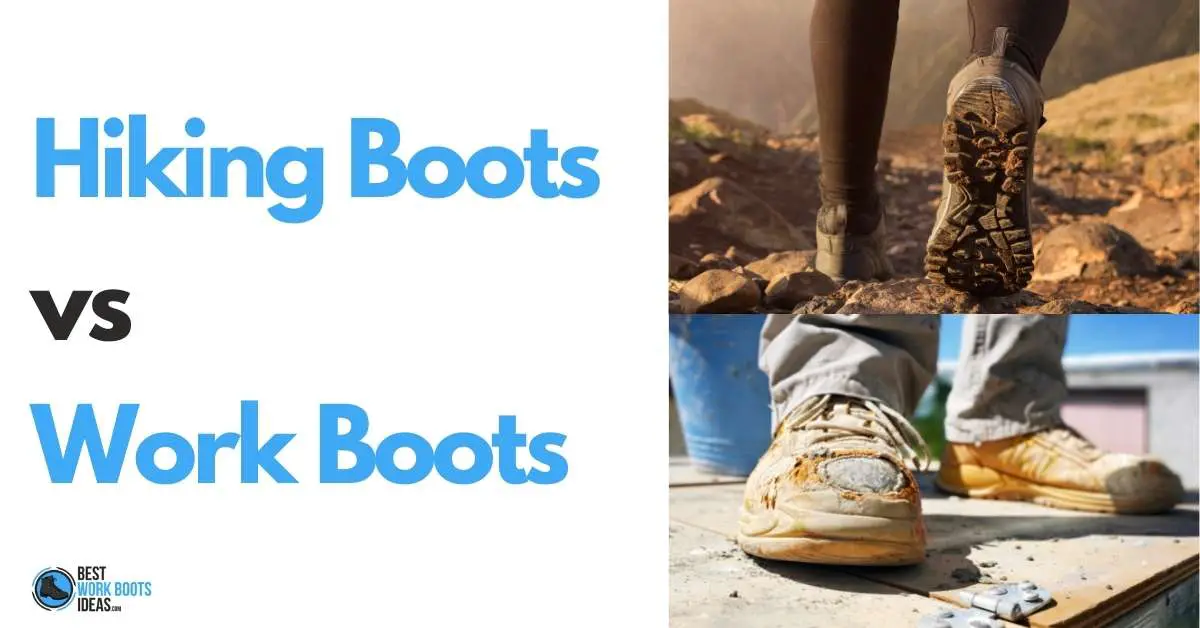
Boots are great, but not all boots are built the same.
There are many different materials, designs, and construction methods that differentiate boots from one another.
Another aspect that differs is the intended purpose of the shoe.
Footwear made for walking around the halls of offices and conference rooms are going to have entirely different features, designs, and focuses than footwear made to help you run better, or footwear to help you work as a lumberjack.
Two styles that get wrapped up together but are actually quite different are hiking boots and work boots.
Many people mistakenly assume that because both boot styles are meant to handle rough usage, they basically perform the same.
While it is true that both are designed to handle difficult situations, the type of difficulty each handles couldn’t be more different.
The type of performance you are going to get from each differs, and I would suggest getting the pair that most closely meets your needs.
But what are your needs? Glad you’re asking, because that’s exactly what I’m going to cover today.
After reading this article you will have a much more complete understanding of the performance you are likely to get from certain boot styles.
You’ll also learn the construction methods, materials and the type of efficiency they deliver to your feet.
This will make it possible for you to see when a work boot would be okay for hiking and vice versa.
On cue, let’s begin getting into the differences that define a work boot from a hiking boot.
Contents
Things to Keep in Mind While Reading This
While reading this, please recognize that whether it’s a work or hiking boot, you’re going to find all varieties of materials and features.
There will be a hiking boot with leather and welts, just as there’s a work boot with synthetics and cemented outsoles.
As I write, for the sake of time, I speak about the construction and material that is most commonly found with that style of boot.
The most important thing is to know what a specific thing does, and how it does it.
Awareness about the pros and cons surrounding each aspect of the construction allows you to see when and where you could buy a boot for an “off brand” purpose.
If you’re unfamiliar with the many different parts that make up a boot, it might be a good time to review those terms so you can follow along more easily.
Uppers, Exteriors
The uppers or exteriors are basically everything on the boot that’s not the midsole and outsole.
They wrap around the top of your foot from toe to where the boot ends at your ankle or leg.
Full-Grain Leather delivers stability at work
With work boots, you’re going to get full-grain leather exteriors that will keep your foot rigid and dry.
This is perfect in situations where you might be standing all day in dirt and gravel that’s been ground into mud by heavy machinery.
You don’t want the boot to bend to meet the terrain, as the terrain is a disaster.
The whole point is to give your foot an ankle structure in situations that don’t have it.
Good leather material provides that stability and rigidity needed in work situations.
Full-grain leather also provides a naturally waterproof material that will keep your feet dry in dirty conditions.
Add Goodyear Welt construction to the mix and you’ll have a work boot that can handle some of the worst work conditions.
In contrast, hiking boots frequently made with synthetics would perform very poorly in this situation.
Within minutes the user would have sore ankles from the stress on muscles and tendons from the unnatural and uneven terrain.
The synthetic materials would offer poor protection against the elements, and even materials advertised as waterproof usually manage to allow some moisture in as time passes.
I know, I know: There are plenty of leather boots that advertise themselves as breathable.
Let’s be honest, even the most breathable leather exteriors are less so than synthetics.
In these dirty situations at work, synthetics can often allow water to seep in just as easily as they claim to allow moisture to escape.
In this instance, I’ll take the less breathable, more waterproof leather exteriors any day of the week.
Synthetic Flexibility On The Trail
There is more to life than work, however, so let’s look into those situations.
On the weekend I usually spend at least one day going for a hike with my wife, and the boots I want for that are entirely different.
I’m not a trail runner and don’t pretend to be.
BUT.
When I’m hiking, I know I’m choosing to take a difficult path and THAT’S the point!
I’m not trying to keep my feet stable on tough terrain while I do something else.
The walking on rough terrain is what I’m doing!
With that in mind, I want boots that can provide me lots of structural flexibility and ankle support as I move my entire feet with the irregularity of the trail.
It’s also nice when the structure of my footwear is light and porous in these situations, so I’m not lifting extra weight all day.
Unlike work, where I’m required to go regardless of the weather, hiking is usually something that I can choose when I do it.
As a result, I won’t choose to go at a time or to a place where I’m going to get gratuitously wet and muddy.
Even if I do, a hike is shorter than a work day, and I could always take a break to let them dry out a bit in the sun if it’s really that horrible.
All this is to say, in this instance I definitely want a highly breathable boot.
The non-stop walking generates heat that is bound to turn to sweat if I’m not wearing something that allows excellent airflow.
Outsoles
Durability vs Versatility
Outsoles are the primary area where work and hiking boots differ, so definitely pay close attention to the following points I’m going to cover.
Nothing delivers stability and reliability like a pair of Goodyear welted boots.
These outsoles are as attached as a sole can be, and will make sure to give you years of performance (with proper care on your part, of course).
At the same time, this style doesn’t afford the wearer much in terms of flexibility.
With uppers affixed to outsoles in so many places, Goodyear Welt construction doesn’t offer much for any athletic performance.
They can take a long term beating at work, but they can’t deliver the peak performance required on challenging trails.
The cement construction usually used to construct hiking shoes does all the things that welted boots do not.
Because the outsole is attached with adhesives instead of stitches, this gives cemented outsoles the ability to bend and adjust to the most treacherous terrain.
It’s like they’re attached everywhere and nowhere, all at once.
There are downsides though, while cemented outsoles provide a boot experience that’s close to a sport shoe, they’re not very durable.
The seal is great at first, but as time passes it will eventually fail and you’ll have to get a new pair of boots.
If someone told me that their welted boots fell apart in a year, I’d tell them to get a refund.
If someone told me the same about their cemented boots, I’d comment that you get what you pay for.
PR, HR, additional outsole features.
Beyond how they’re usually attached, the types of outsoles you’ll find differs between work and hiking footwear.
Starting with the lug pattern, work boots tend to have thicker, deep lugs, and patterns that attempt to create a level surface for the user.
Hiking boots, on the other hand, have a less regular, less deep cut pattern that helps someone find their footing.
Their pattern is designed for someone who’s walking over extremely irregular terrain and asking irregular positions of their feet.
There’s also the greater likelihood that you’ll find work boots with outsoles that feature slip, puncture, and heat resistance.
These are features that are extremely helpful on worksites, but wouldn’t add too much to your hiking experience.
For that reason it’s rarer to see hiking shoes that offer these outsole features.
Major Differences Review
Flexibility
Hiking boots will usually outperform work boots in terms of flexibility and mobility as the mixture of their construction methods and materials allows for advanced performance.
This is great when you’re going uphill on a rocky trail, but not so great on a work site.
Work boots are more likely to be rigid and support your body while working.
Unlike situations on a trail, at work you want your boots to create stability for you where there is none.
Weight
Work boots are almost always heavier, as they will be made with thicker, denser materials.
They also include materials like a toecap that aren’t always found in hiking boots.
Hiking boots are generally lighter as they’re designed to be used in extremely unusual terrain that will tire your legs out.
Safety
Which style boot is safest entirely depends on the activity it’s being used for.
If I was down the staircase like the one shown (it went forever), I would want a hiking boot because I’m more concerned that I can feel exactly where my feet are beneath me.
If I was on a worksite where there were heavy objects around and I wanted to have a solid foundation beneath me as I did my work, I would turn to a work boot.
Safety is a word that means different things at different times.
If it’s 100 degrees, being safe means drinking water.
At 20 degrees, it’s remembering to bring gloves and a hat.
Know your circumstances and from there you’ll know your best bet.
Now you know the different materials and methods that make up the difference between hiking and work boots.
